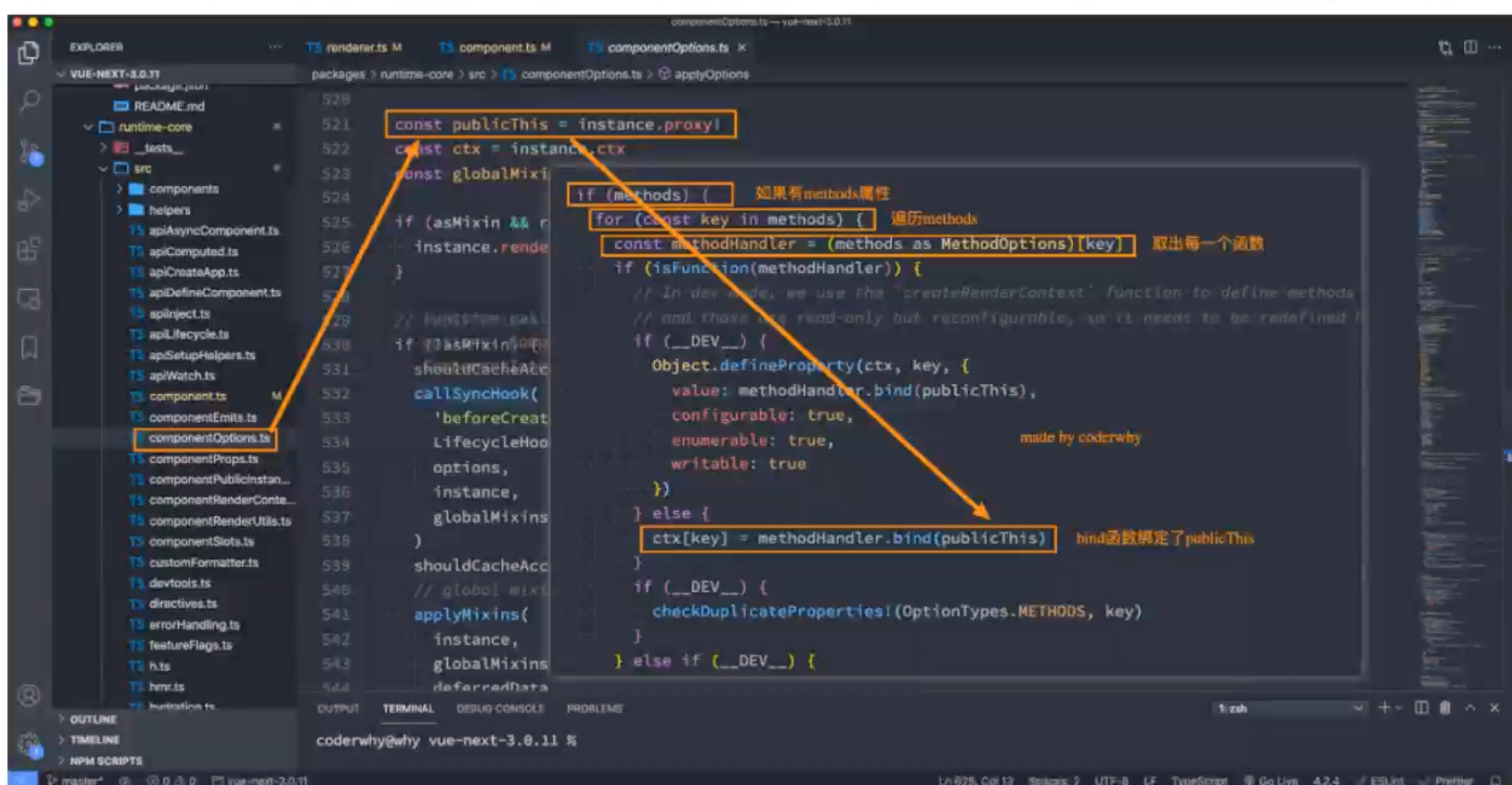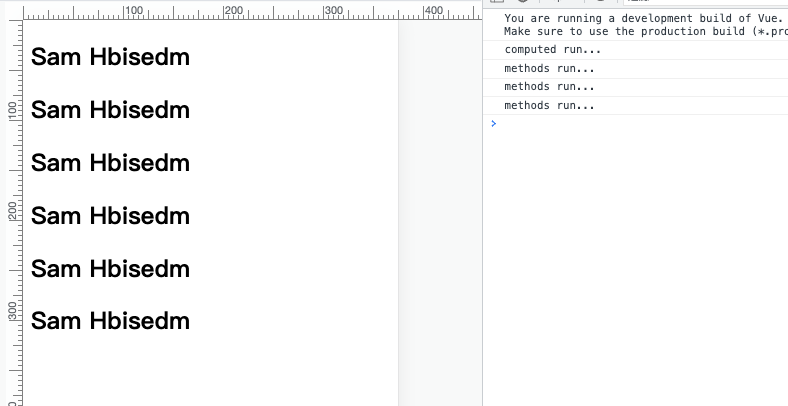#tag
基本知识的笔记
method方法绑定的this

mustache语法

语法使用
常用指令
v-once
只会渲染一次
| <template id="my-app">
<h2>{{ message }}</h2>
<h2 v-once>{{ message }}</h2>
<button @click="changeMsg">改变</button>
</template>
|
1
2
3
4
5
6
7
8
| methods: {
changeMsg() {
this.message = ((Math.random() * 100000) + '').split(10).join('')
}
}
|
每次点击改变按钮时,v-once指令的当前元素与子元素都不会重新渲染
v-text
1
2
| <h2>{{message}}</h2>
<h2 v-text="message"></h2>
|
上下代码,html的效果一致
v-html
1
2
3
4
5
6
7
| <template id="my-app">
<h2>{{message}}</h2>
<div v-html="htmlParam"></div>
</template>
|
1
2
3
4
5
6
7
8
9
10
11
12
13
14
|
```data() {
return {
message: "Hello World",
htmlParam: `
<h1>Hello Vue</h1>
`
}
}
|
使用v-html解析出html标签的显示,若使用v-text会导致html标签也跟着显示出来,没有进行解析
v-pre
v-pre会跳过元素和子元素的编译过程,显示原始的Mustache标签
1
2
3
4
| <template id="my-app">
<h2>{{message}}</h2>
<div v-pre>{{data}}</div>
</template>
|
vue optionAPI的data中也没有定义data这个变量
console中没有报错,证明使用v-pre后vue没有去解析Mustache语法的内容
v-bind
一些注意点
1
| <div :style="{color: colorParam, 'font-size': fontParam}">test</div>
|
对于一些有-的css属性,可以使用驼峰形式也可以使用-,如:fontSize与font-size,但是使用-的话,就得加入""引号。
绑定对象属性
1
2
3
| <div v-bind="info"></div>
->
<div age="12" name="Sam"></div>
|
1
2
3
4
5
6
7
8
| data(){
return {
info: {
age: 12,
name: 'Sam'
}
}
}
|
v-on
v-on内使用对象,可以传递多个对象属性进行与对应方法绑定,进行触发。
1
| <div v-on="{click: clickEvent}">点击</div>
|
1
2
3
4
5
| methods: {
clickEvent() {
console.log('click event handler...')
}
}
|
修饰符
v-on支持修饰符,修饰符相当于对事件进行了一些特殊的处理:
.stop - 调用 event.stopPropagation()。
.prevent - 调用 event.preventDefault()。
.capture - 添加事件侦听器时使用 capture 模式。
.self - 只当事件是从侦听器绑定的元素本身触发时才触发回调。
.{keyAlias} - 仅当事件是从特定键触发时才触发回调。
.once - 只触发一次回调。
.left - 只当点击鼠标左键时触发。
.right - 只当点击鼠标右键时触发。
.middle - 只当点击鼠标中键时触发。
.passive - { passive: true }模式添加侦听器。
v-if 与 v-show的区别
用法上
- v-show是不支持template
- v-show不可以和v-else一起使用
本质上
- v-show元素无论是否需要显示到浏览器上,它的DOM实际都是有渲染的,只是通过CSS的display属性来进行切换
- v-if当条件为false时,其对应元素压根不会被渲染到DOM上
开发中如何进行选择
- 如果我们开发的元素需要在显示和隐藏之间频繁的切换,那么使用v-show
- 如果不会频繁的发生切换,那么使用v-if
v-for
v-for遍历对象
1
2
3
| <p v-for="(value, key, index) in info">
{{value}}-{{key}}-{{index}}
</p>
|
1
2
3
4
5
| info: {
age: 12,
name: 'Sam',
Sex: 'Male'
}
|

遍历数字
1
| <div v-for="num in 10">{{num}}</div>
|
计算属性 computed
computed:计算属性
字面意思:计算我们的属性,所以每次计算后,除非所依赖的属性发生了变化,不然他不会执行计算的,也就是它的缓存性。
与methods的区别
1
2
3
4
5
6
| <h2>{{fullName}}</h2>
<h2>{{fullName}}</h2>
<h2>{{fullName}}</h2>
<h2>{{getFullName()}}</h2>
<h2>{{getFullName()}}</h2>
<h2>{{getFullName()}}</h2>
|
1
2
3
4
5
6
7
8
9
10
11
12
13
14
15
16
17
18
| data() {
return {
firstName: 'Sam',
lastName: 'Hbisedm'
}
},
computed: {
fullName() {
console.log('computed run...');
return `${this.firstName} ${this.lastName}`
}
},
methods: {
getFullName() {
console.log('methods run...');
return `${this.firstName} ${this.lastName}`
}
}
|
效果:

证明:
计算属性方法是具有缓存性的。
getter
1
2
3
4
5
6
7
| computed: {
fullName() {
console.log('computed run...');
return `${this.firstName} ${this.lastName}`
},
}
|
默认函数写法就是getter,使用对象写法可以写getter还可以写setter
1
2
3
4
5
6
7
8
9
10
11
| computed: {
fullName: {
get: function() {
return `${this.firstName} ${this.lastName}`
},
set: function(val) {
this.firstName = val
console.log(val)
}
}
}
|
- 当程序调用
this.fullName = xxx时,会自动调用fullName的setter方法
- 而setter方法会里面会改变
this.firstName导致fullName的getter方法自动再次执行。
侦听器 watch
侦听某些数据的变化,需要使用watch。
1
2
3
4
5
6
7
8
9
| <template id="my-app">
<p>base data</p>
<input v-model.lazy="message" />
<p>object</p>
<p>{{ info.name }}</p>
<button @click="changeObj">change obj</button>
<button @click="changeAttr">change obj attr</button>
</template>
|
1
2
3
4
5
6
7
8
9
10
11
12
13
14
15
16
17
18
19
20
21
22
23
24
25
26
27
28
29
30
| const App = {
template: '#my-app',
data() {
return {
message: "Hello World",
info: {
name: 'Sam0',
age: 23
}
}
},
watch: {
message(newVal, oldVal) {
console.log('new: ' + newVal, 'old: ' + oldVal);
},
info(newVal, oldVal) {
console.log('new: ' + newVal, 'old: ' + oldVal);
},
},
methods: {
changeObj() {
this.info = {
name: "Sam1"
}
},
changeAttr() {
this.info.name = "Sam2"
}
}
}
|
无论是基本数据还是引用类型的数据,只要改变了就会监听到。但如果是改变了对象里面的属性值,watch不会监听到,因为原来对象的内存地址没有进行修改。
那我们开发过程中需要监听对象里面的属性的情况下:
1
2
3
4
5
6
7
8
9
| info: {
handler: function (newVal, oldVal) {
console.log('new: ' + newVal, 'old: ' + oldVal);
},
deep: true
}
"info.name": function(newVal, oldVal) {
}
|
我们想watch里面某些正在监听的data在页面加载后立即执行一次(上面代码是当后面data改变后才执行watch)
1
2
3
4
5
6
7
| info: {
handler: function (newVal, oldVal) {
console.log('new: ' + newVal, 'old: ' + oldVal);
},
deep: true,
immediate: true
}
|
一些其他用法
1
2
3
4
5
6
7
8
9
10
11
12
13
14
15
16
| watch: {
message: '对应的方法名'
}
watch: {
message: [
'对应方法名',
{
handler: function(newVal, oldVal) {
}
},
handler2(newVal, oldVal) {
}
]
}
|
- 可以传递字符串,使用对应的方法名
- 可以传递数组,使用对应的一系列回调
使用$watch
1
2
3
4
5
6
7
8
9
10
| created() {
const unwatch = this.$watch("info", (newVal, oldVal) => {
console.log('$watch newVal: ' + newVal, '$watch oldVal: ' + oldVal);
}, {
deep: true,
immediate: true
})
unwatch()
}
|



